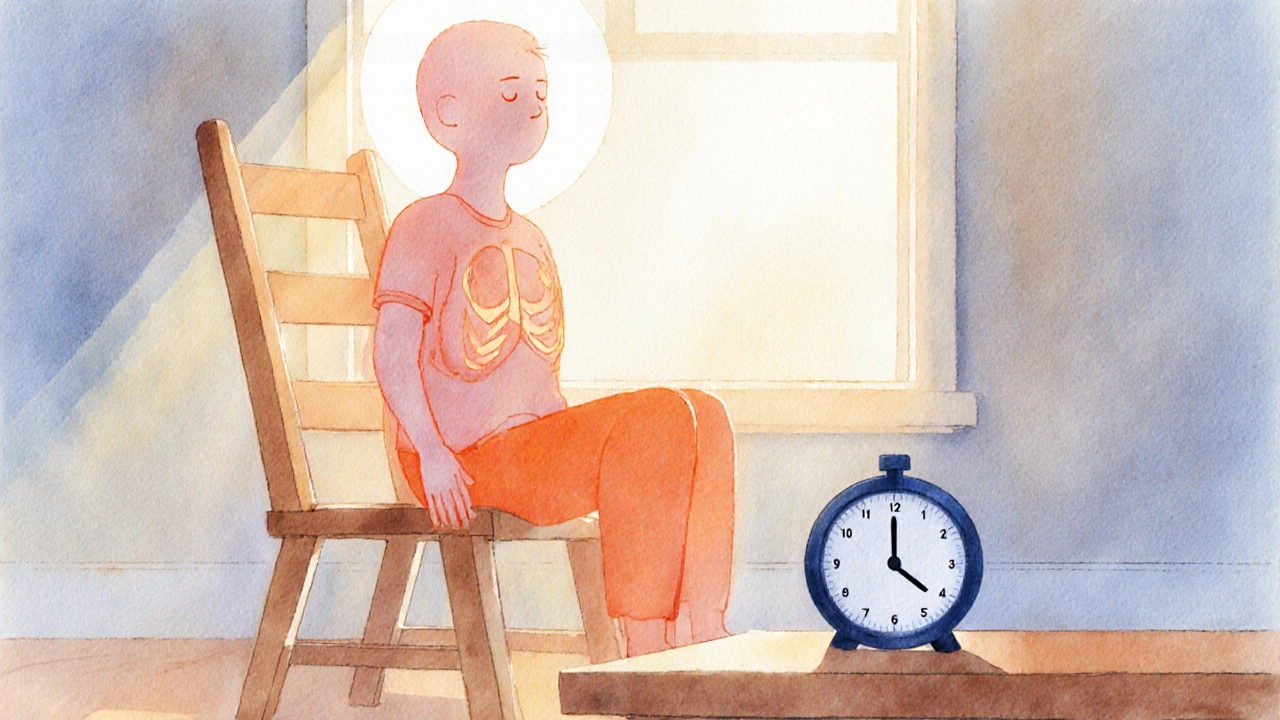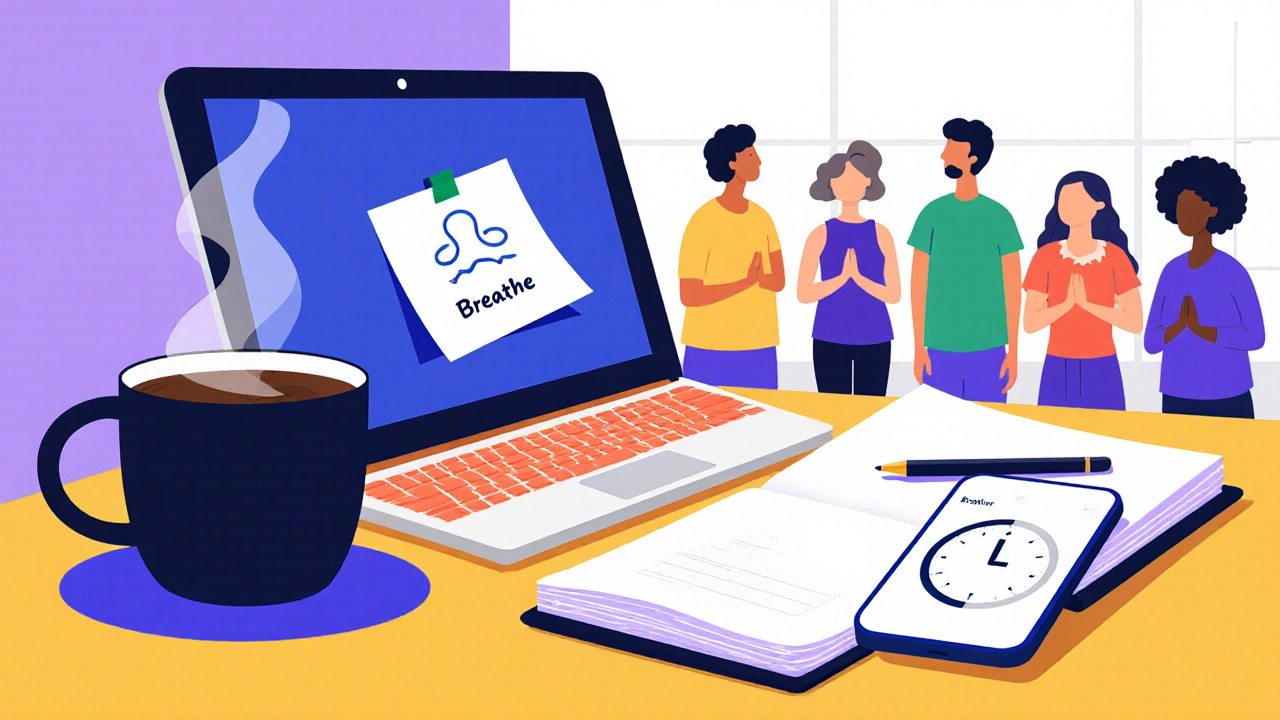Mindfulness Timer for Beginners
Focus on your breath
Pro Tip: When thoughts wander, gently label them "thinking" and return to your breath. This is the core practice—not emptying your mind but observing without judgment.
Ever felt your mind racing like traffic during rush hour, then wondered if there’s a simple switch to hit and calm the chaos? That switch is called mindfulness. It’s not a mystical power reserved for monks-anyone can tap into it with a few minutes a day. This guide shows exactly where a total beginner should begin, why the first steps matter, and how to turn a short practice into a lasting habit.
What Mindfulness Really Is
Mindfulness is a mental habit of paying attention to the present moment, on purpose and without judgment. In everyday language, it means noticing the taste of your coffee, the feel of your feet on the floor, or the rhythm of your breath, instead of letting thoughts drift unchecked. It differs from "relaxation" because you stay alert; you simply observe.
Why Start Now? The Benefits Backed by Numbers
Research from Harvard Medical School in 2024 found that an eight‑week mindfulness program cut self‑reported stress levels by 38% and improved sleep quality for 62% of participants. A meta‑analysis covering 71 trials showed a consistent 0.35‑standard‑deviation boost in anxiety scores after just 20 minutes of daily practice. These aren’t tiny changes-over time they translate into lower blood pressure, better focus at work, and a stronger immune response.
Common Myths that Hold Beginners Back
- Myth: You need to empty your mind completely.
Reality: The goal is to notice thoughts, not erase them. - Myth: You must sit in silence for hours.
Reality: Even a 3‑minute pause counts. - Myth: It’s a religious practice.
Reality: Mindfulness is a secular skill used in schools, hospitals, and corporate offices.

Step‑by‑Step: Your First 5‑Minute Routine
- Choose a cue. Pick a daily moment-like brushing your teeth-as the reminder to be present.
- Set a timer. Use your phone or a kitchen timer for 3-5 minutes.
- Find a comfortable seat. Sit on a chair with feet flat, or cross‑legged on a cushion. Keep the spine tall.
- Focus on the breath. As you inhale, notice the rise of your chest; as you exhale, feel the release. When thoughts wander, gently label them "thinking" and bring attention back.
- Close with gratitude. Before the timer ends, silently thank yourself for showing up.
Do this daily for a week. If you miss a day, simply restart-mindfulness isn’t about perfection.
Core Techniques to Expand Your Practice
Once the basic breathing routine feels natural, add one of these techniques each week.
| Technique | Focus Area | Typical Duration | Best For |
|---|---|---|---|
| Breathing Exercise - a core practice that anchors attention to the inhale‑exhale cycle. | Breath | 3-10 minutes | Beginners, stress relief |
| Body Scan - systematically notice sensations from head to toe. | Physical sensations | 10-20 minutes | Sleep preparation, chronic pain |
| Mindful Walking - walk slowly while noticing each step. | Movement | 5-15 minutes | Office breaks, outdoor lovers |
| Loving‑Kindness - silently repeat phrases of goodwill. | Emotions | 5-10 minutes | Relationships, self‑compassion |
Breathing Exercise
Set a timer for four breaths, then count silently. When the mind drifts, label the distraction "thinking" and start again. This simple loop builds the neural pathways of attention, a process known as Neuroplasticity.
Body Scan
Lie down or sit comfortably. Begin at your toes, notice warmth, tingling, or pressure. Move slowly upward-feet, calves, knees, hips, abdomen, chest, shoulders, neck, face. No need to change anything; just observe.
Mindful Walking
Choose a quiet corridor or a park path. With each step, feel the heel lift, the foot roll, the ground contact. Synchronize breath: inhale for three steps, exhale for three. This keeps the mind anchored while you stay active.
Loving‑Kindness
Silently repeat: "May I be safe, may I be healthy, may I be happy, may I live with ease." After a few minutes, extend the wishes to a friend, then a neutral person, then someone you find challenging. This practice boosts empathy and lowers cortisol.
Turning Practice into a Habit
Building a consistent routine is the biggest hurdle. Here are three proven tricks:
- Anchor to an existing habit. Link your mindfulness cue to something you already do-like a coffee break.
- Use a visual reminder. Place a sticky note that says "Breathe" on your monitor.
- Track progress. A simple journal entry (date, technique, minutes) reinforces accountability.
Expect occasional resistance. When your brain resists, remember the research: each minute of mindful attention strengthens the prefrontal cortex, the part responsible for self‑control. In other words, a little effort compounds into real brain change.

Tools, Apps, and Resources for Beginners
While you can practice anywhere, a few digital aids smooth the learning curve.
- Insight Timer. Over 100,000 free guided meditations, including 3‑minute “quick reset” tracks.
- Headspace. Structured 10‑day beginner course; good for visual learners.
- Books. Wherever You Go, There You Are by Jon Kabat‑Zinn (classic) and The Mindful Way Through Stress by Shamash Alidina (practical).
- Community classes. Many local libraries and yoga studios in Adelaide host free weekly mindfulness sessions-great for social motivation.
Key Takeaways
- Mindfulness is a skill, not a talent; start with 3‑minute breaths.
- Consistent daily practice yields measurable reductions in stress and anxiety.
- Expand gradually: breathing → body scan → walking → loving‑kindness.
- Anchor to existing habits, use visual cues, and log minutes to solidify the habit.
- Free apps and community groups provide structure without cost.
Frequently Asked Questions
How long should a beginner practice mindfulness each day?
Start with 3-5 minutes and increase by one minute each week until you reach 10-15 minutes. Consistency beats length.
Do I need a quiet room to practice?
No. A noisy office works fine if you focus on the breath and treat external sounds as data, not distraction.
Can mindfulness help with chronic pain?
Yes. Studies show body‑scan meditation reduces perceived pain intensity by up to 30% compared with standard care.
Is it okay to think about my to‑do list during meditation?
If thoughts arise, simply note them (e.g., "planning") and return to the breath. The goal isn’t to block thoughts but to change your relationship to them.
How quickly can I notice benefits?
Many beginners report reduced tension and clearer focus after just a few days of regular practice. Longer‑term benefits like lower anxiety emerge after 4-6 weeks.







